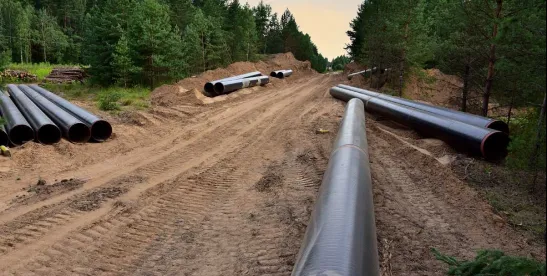Following the election wins we reported on in November 2024, state and local bans on the use of natural gas remain a highly litigated issue across the country. In this alert, we cover two recent cases dealing with local and state natural gas bans. First, we discuss a March 2025 federal district court decision upholding a New York City natural gas ban against arguments that it is preempted by the federal Energy Policy and Conservation Act (EPCA). In contrast, we reported previously on a 2023 Ninth Circuit decision striking down a City of Berkeley law prohibiting gas piping in new buildings. The recent New York decision has the potential to lead to a circuit split and potentially to the United States Supreme Court. Second, we provide an update on a March 2025 Washington state court decision that struck down a voter initiative addressing the use of gas and gas bans in the state.
The US District Court for Southern District of New York Upholds New York’s Gas Ban
In Association of Contracting Plumbers of New York, Inc. v. City of New York, the US District Court for the Southern District of New York upheld New York City’s Local Law 154, which generally prohibits the use of fossil fuel, such as natural gas, for heating in newly constructed residential buildings.1 Plaintiffs, which included six trade associations and a union whose members work in the construction, delivery, and servicing of fuel gas systems and appliances, argued that Local Law 154 is expressly preempted by EPCA.2 The city moved to dismiss the complaint, arguing that EPCA does not preempt Local Law 154.3 The court found that Law 154 does not “concern” “energy use” of covered products, as defined by EPCA, because Law 154 regulates the type of fuel used rather than the energy efficiency or use of the products themselves, which is what EPCA covers.4
In reaching this conclusion, the court took a markedly different approach to EPCA preemption than the US Court of Appeals for the Ninth Circuit in California Restaurant Association v. City of Berkeley. In Berkeley, the Ninth Circuit found that a city-level ordinance that prohibited natural gas piping in new buildings was preempted by EPCA.5 We covered that decision here and provided an update regarding the case in February 2024. The S.D.N.Y. decision marks a victory for natural gas ban proponents. If the court’s finding is appealed and upheld by the US Court of Appeals for the Second Circuit, the circuit split could result in an appeal to the US Supreme Court for final resolution on whether EPCA preempts state and local gas bans.
The Ninth Circuit’s and S.D.N.Y.’s Different Approaches to EPCA Preemption
EPCA establishes “national energy conservation standards for major residential appliances”6 and aims to “avoid the burdens of a patchwork of conflicting and unpredictable State regulations.”7 EPCA preempts state regulations “concerning the . . . energy use” of covered products.8 Faced with a lawsuit challenging a gas ban under EPCA, a court therefore must determine both the meaning of “energy use” and whether the local law at issue “concerns” “energy use” within the meaning of EPCA.9
Meaning of “Energy Use” Under EPCA
The court in Berkeley interpreted “energy use” broadly, including “not only from where the product rolls off the factory floor, but also from where consumers use the products.”10 The Berkeley court explained that EPCA preempts regulations, including building codes, that “relate to” the quantity of natural gas directly consumed by certain consumer appliances at the place where those products are used.11 Because EPCA is concerned with the end-user’s ability to use installed covered products at their intended final destinations, the court concluded that the plain language of EPCA preempts Berkeley’s regulation that prohibits the installation of necessary natural gas infrastructure on premises where covered appliances are used.12
The federal district court in New York took a different approach, interpreting “energy use” narrowly to mean a fixed value, determined using administratively prescribed testing procedures, that represents the amount of energy a product consumes under typical conditions.13 The district court declined to adopt the Ninth Circuit’s view, explaining that it rests on a flawed reading of the term “point of use.”14 In Berkeley, the Ninth Circuit defined “point of use” broadly to mean the “place where something is used,” which led it to conclude that “EPCA is concerned with the end-user’s ability to use installed covered products at their intended final destinations.”15 In contrast, the New York court determined that “point of use” is a technical term that must be interpreted in accordance with its specialized meaning.16
The New York court explained that “point of use” specifically means only that a covered product’s “energy use,” when determined in accordance with prescribed test procedures, should be measured without adjustment for any energy loss in the generation, transmission, and distribution of energy.17 Such a definition neither expands EPCA’s scope to reach the actual use of covered products nor grants consumers an absolute right to use such products.18 Rather, the definition fits within the statutory definition of “energy use,” which refers to a covered product’s characteristics as manufactured.19 Ultimately, the New York court concluded that “energy use” refers to a “predetermined fixed value that measures the characteristics of a covered product as manufactured.”20
Whether the Law “Concerns” “Energy Use”
Once a federal energy conservation standard takes effect for a covered product, state regulations concerning the product’s energy efficiency or “energy use” are preempted.21
In Berkeley, the Ninth Circuit determined that local bans on natural gas infrastructure on premises where covered products are used indirectly affect the use of those products and thus are preempted by EPCA.22
The court explained that the language “concerns” has “a broadening effect, ensuring that the scope of a provision covers not only its subject but also matters relating to that subject.”23 The court took an expansive view of the term, concluding that “a building code that bans the installation of piping that transports natural gas from a utility’s meter on the premises to products that operate on such gas ‘concerns’ the energy use of those products as much as a direct ban on the products themselves.”24 While this ruling appears to close the door on local gas bans, the Ninth Circuit stated that EPCA’s preemption may apply narrowly to building codes that target the on-site use of natural gas and signaled that state and local governments may have broader authority to regulate utility distribution of natural gas.25
In contrast, New York held that EPCA does not preempt regulations that do not directly impose energy conservation standards on products.26 The court explained that Local Law 154 does not have a connection with EPCA’s subject matter because it does not “focus on” the performance standards applicable to covered products.27 Local Law 154 indirectly regulates the type of fuel that a covered product may consume in certain settings, irrespective of that product’s energy efficiency or use. The court reasoned that it would be an absurd result if indirect regulation of this sort was preempted by EPCA.28
The court said that state laws like Local Law 154 do not risk creating a patchwork of conflicting standards because they neither require anything of manufacturers nor constrain their activities.29 It concluded that prohibiting certain fuel types in certain settings does not impose performance standards by proxy, and therefore, Local Law 154 does not “reference” the subject matter of EPCA.30 Local Law 154 is not preempted because it does not “relate to” and thus does not “concern,” “energy use” within the meaning of EPCA.31 Given that EPCA’s preemption clause does not apply, the court found that Plaintiffs failed to state a claim upon which relief can be granted and accordingly granted the motion to dismiss.32
Implications of the Ninth Circuit’s and S.D.N.Y.’s Distinct Approaches to EPCA
The divergent applications of EPCA in these cases illustrate the current unpredictable nature of how courts will assess natural gas bans under EPCA. The Berkeley decision limits local authority to enact gas bans by reading EPCA’s preemptive scope broadly to include even indirect regulations on “energy use.” The New York decision preserves local regulatory power by focusing only on direct regulations of product standards. It remains to be seen how other courts in other parts of the country will apply EPCA to natural gas bans.
Another battle over natural gas’ future is also playing out in Washington state. On 21 March 2025, a King County Superior Court judge ruled that Washington state Initiative 2066 violates the state constitution’s single subject rule, which provides that voter initiatives can only address a single subject. Our November 2024 alert covered natural gas’ election wins and losses, including the passage of Initiative 2066, which was designed to protect natural gas access in the state and to bar local governments from banning its use. While the superior court’s decision did not directly address EPCA preemption, federal court decisions on EPCA are undoubtedly shaping these issues across the country. We are continuing to monitor this case for an appeal and are keeping a close eye on other efforts to protect or ban natural gas from New York to California and Washington. Check back on our page for updates.
FOOTNOTES
1 Association of Contracting Plumbers of the City of New York, et al. v. City of New York, No. 23-CV-11292 (RA), 2025 WL 843619, at *6-7 (S.D.N.Y. Mar. 18, 2025) (New York).
2Id. at *2.
3Id. at *2.
4Id. at *6-7.
5 Cal. Rest. Ass’n v. City of Berkeley, 65 F.4th 1045 (Apr. 17, 2023); See also David L. Wochner, Benjamin A. Mayer, John Longstreth, Nathan C. Howe, Timothy J. Furdyna, and David Wang, U.S. Court of Appeals for the Ninth Circuit Cans Berkeley Gas Ban Under Federal Law, 23-7 PRATT’S ENERGY LAW REPORT 243 (LexisNexis A.S. Pratt). In that case, the appeals court found that EPCA’s preemption clause extends to regulations that (i) directly address the covered products, or (ii) affect the on-site infrastructure related to the use of those products. The Ninth Circuit concluded that EPCA preempted Berkeley’s ban because it prohibited the onsite installation of natural gas infrastructure necessary to support covered natural gas appliances.
6 S. Rep. 100-6, at 2 (1987).
7 Id. at 12.
8 42 U.S.C. § 6297(c).
9 See New York, 2025 WL 843619, at *4.
10 See Berkeley, 89 F.4th at 1103. EPCA defines “energy use” as “the quantity of energy directly consumed by a consumer product at point of use, determined in accordance with test procedures under section 6293 of this title.” 42 U.S.C. § 6291(4). Section 6293 requires those procedures to be “reasonably designed to produce test results which measure [the] . . . energy use . . . of a covered product during a representative average use cycle or period of use.” 42 U.S.C. § 6293(b)(3).
11 Id. at 1102 (9th Cir. 2024).
12 Id.
13 New York, 2025 WL 843619, at *4-5.
14 Id. at *5.
15 Berkeley, 89 F.4th at 1102.
16 See New York, 2025 WL 843619, at *5.
17 Id. (citing to Energy Intensity Indicators: Terminology and Definitions, U.S. Dep't of Energy, https://www.energy.gov/eere/analysis/energy-intensity-indicators-terminology-and-definitions).
18 Id.
19 Id.
20 Id.
21 Id. at *6 (citing to 42 U.S.C. § 6291(6)).
22 Berkeley, 89 F.4th at 1102.
23 Id. at 1103 (citing Lamar, Archer & Cofrin, LLP v. Appling, 584 U.S. 709, 138 S. Ct. 1752, 1759, 201 L. Ed. 2d 102 (2018)).
24 Id. at 1103.
25 Berkeley, 89 F.4th at 1103.
26 See New York, 2025 WL 843619, at *5-7.
27 Id. at *6.
28Id.
29Id. at *7 (citing to Dan’s City Used Cars, Inc. v. Pelkey, 569 U.S. 251, at 263–64 (2013)).
30Id. at *7.
31 Id.
32 Id. at *3, 7.









 />i
/>i

